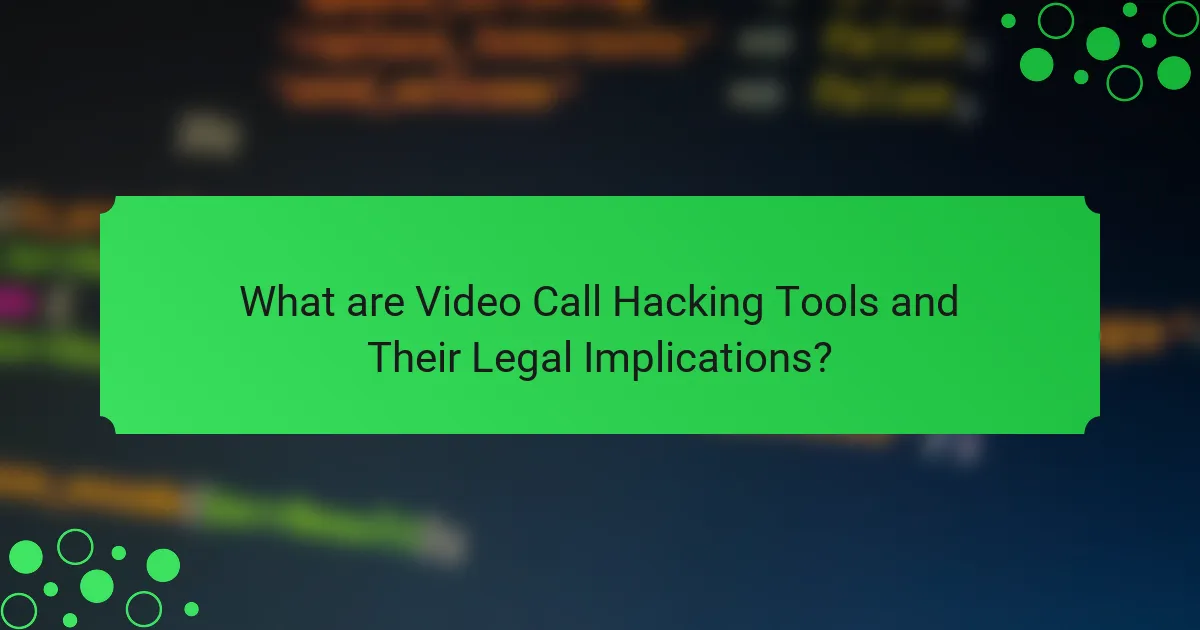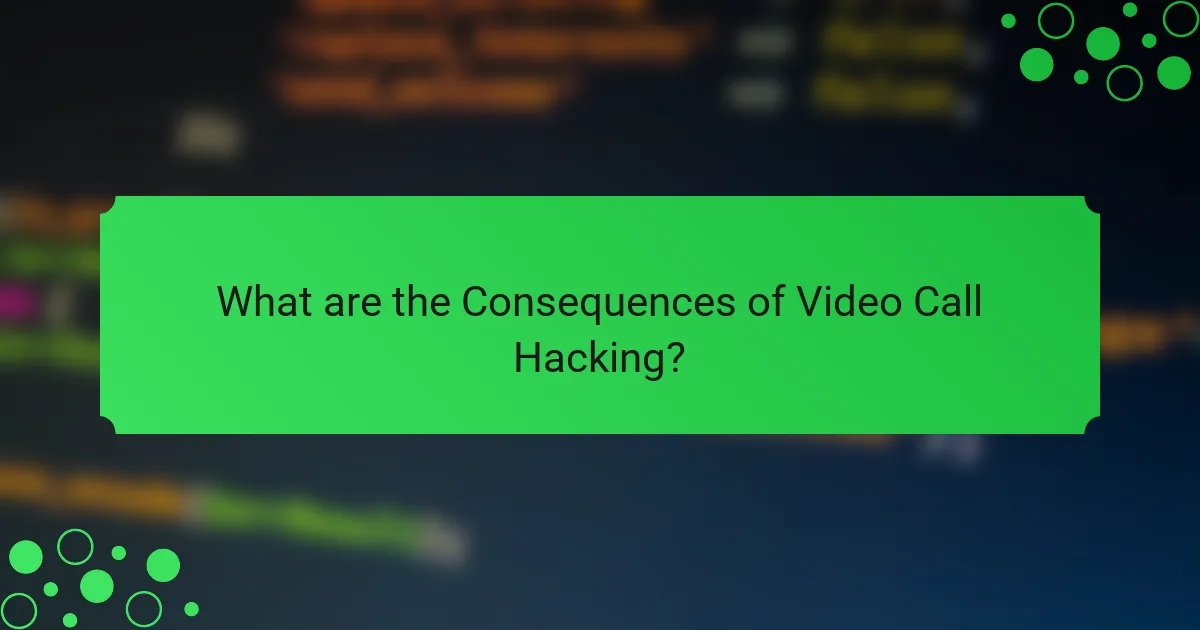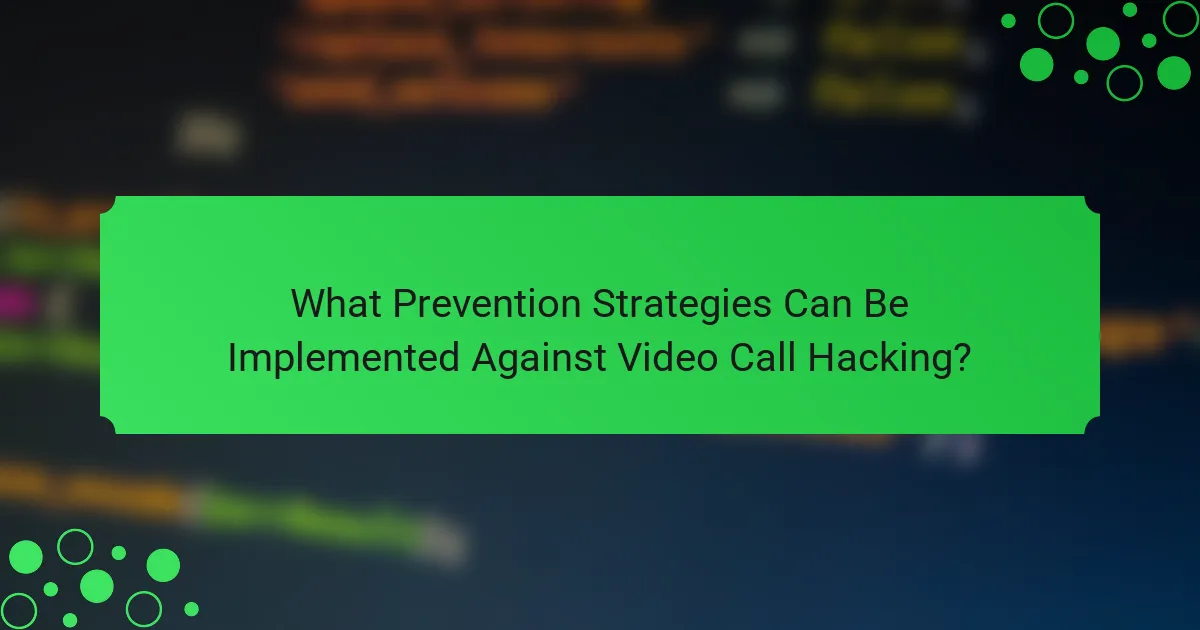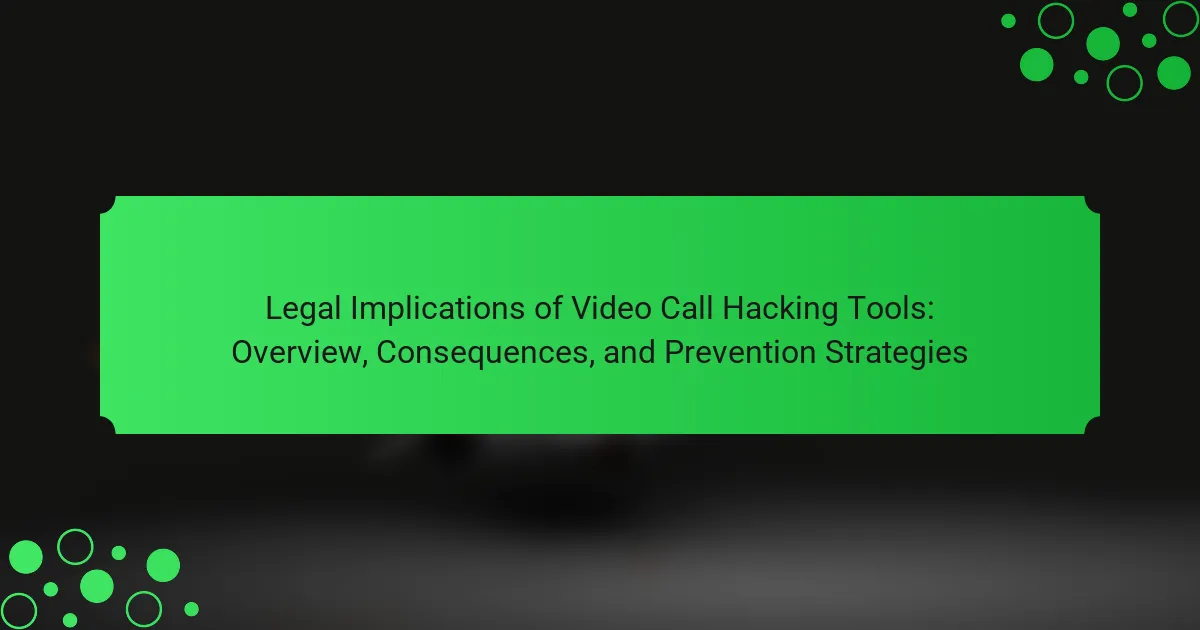Video call hacking tools refer to software or methods that enable unauthorized access to video conferencing platforms, such as Zoom, Microsoft Teams, or Google Meet. The use of these tools can lead to significant privacy violations, data breaches, and unauthorized surveillance, resulting in legal consequences including charges for hacking and violations of privacy laws. The article outlines the severe implications of video call hacking, including identity theft and reputational damage, as well as the financial repercussions for organizations that fail to safeguard user data. Additionally, it provides prevention strategies, such as utilizing strong passwords, enabling two-factor authentication, and employing end-to-end encryption, to mitigate the risk of video call hacking incidents.

What are Video Call Hacking Tools and Their Legal Implications?
Video call hacking tools are software or methods used to gain unauthorized access to video conferencing platforms. These tools can exploit vulnerabilities in applications like Zoom, Microsoft Teams, or Google Meet. Their use can lead to privacy violations, data breaches, and unauthorized surveillance. Legal implications include potential charges for hacking, violating privacy laws, and civil lawsuits. In many jurisdictions, hacking is a criminal offense punishable by fines or imprisonment. The Computer Fraud and Abuse Act in the U.S. addresses unauthorized access to computer systems. Additionally, GDPR and other data protection laws impose strict penalties for breaches involving personal data.
How are video call hacking tools defined in legal terms?
Video call hacking tools are generally defined in legal terms as unauthorized software or methods used to access, disrupt, or manipulate video conferencing systems. These tools may be classified under laws related to cybercrime, privacy violations, and unauthorized access to computer systems. In many jurisdictions, using such tools can lead to criminal charges, including hacking or identity theft. Legal frameworks often address the unauthorized interception of communications, which can include video calls. For instance, the Computer Fraud and Abuse Act in the United States prohibits unauthorized access to protected computers. Violations can result in severe penalties, including fines and imprisonment.
What specific laws govern the use of video call hacking tools?
The use of video call hacking tools is governed by various laws, primarily focused on unauthorized access and privacy violations. In the United States, the Computer Fraud and Abuse Act (CFAA) makes it illegal to access a computer system without authorization. Similarly, the Electronic Communications Privacy Act (ECPA) prohibits the interception of electronic communications. In many jurisdictions, laws regarding wiretapping and surveillance also apply, requiring consent from parties involved in the communication. Violating these laws can result in criminal charges and civil liabilities. These legal frameworks are designed to protect individuals’ privacy and the integrity of communication systems.
How do jurisdictional differences affect the legality of these tools?
Jurisdictional differences significantly impact the legality of video call hacking tools. Different countries and states have varying laws regarding cybersecurity and privacy. For instance, some jurisdictions may classify hacking tools as illegal under strict anti-hacking statutes. Others may allow certain uses under specific conditions, like research or ethical hacking. The enforcement of these laws can also differ widely. In some regions, authorities may actively pursue legal action against users of such tools. In contrast, other areas may lack enforcement resources or prioritize different crimes. This inconsistency creates a complex legal landscape for individuals and organizations using these tools. Consequently, users must navigate these differences to avoid legal repercussions.
What are the potential legal consequences of using video call hacking tools?
Using video call hacking tools can lead to serious legal consequences. Unauthorized access to video calls typically violates laws related to wiretapping and privacy. Many jurisdictions classify such actions as felonies, resulting in significant fines or imprisonment. For instance, the U.S. Wiretap Act imposes penalties for intercepting communications without consent. Victims may also pursue civil lawsuits for damages caused by such invasions. Additionally, using these tools can damage reputations and lead to professional consequences. Legal repercussions can vary by location but generally include both criminal and civil liabilities.
What criminal charges can arise from the unauthorized use of these tools?
Unauthorized use of video call hacking tools can lead to several criminal charges. These charges may include unauthorized access to computer systems, which is a violation of the Computer Fraud and Abuse Act in the United States. Another potential charge is wiretapping, as intercepting communications without consent is illegal under federal and state laws. Additionally, individuals may face identity theft charges if personal information is stolen during the unauthorized use. There can also be charges related to harassment or stalking if the tools are used to invade someone’s privacy. Legal consequences vary by jurisdiction, but penalties can include fines and imprisonment.
How can civil liability impact individuals and organizations involved?
Civil liability can significantly impact individuals and organizations involved in video call hacking. It may lead to financial penalties for damages caused by unauthorized access to private communications. Individuals may face lawsuits from victims seeking compensation for emotional distress or financial losses. Organizations could suffer reputational harm, resulting in loss of clients and trust. Legal costs can escalate as entities defend against claims, draining resources. In severe cases, civil liability may lead to regulatory scrutiny and increased oversight. This can result in stricter compliance requirements and potential operational changes. Overall, civil liability creates a substantial risk that can affect both personal and organizational stability.
What ethical considerations surround the use of video call hacking tools?
The use of video call hacking tools raises significant ethical considerations. These tools invade privacy, compromising the confidentiality of communications. Unauthorized access to video calls violates trust between participants. Ethical implications also include the potential for harassment and manipulation. Such actions can lead to emotional distress for victims. Additionally, the misuse of these tools can undermine the integrity of professional environments. Legal frameworks often struggle to keep pace with technological advancements, complicating ethical accountability. Overall, the ethical concerns focus on privacy, consent, and the potential for harm.
How do ethical implications intersect with legal frameworks?
Ethical implications intersect with legal frameworks by influencing the formulation and enforcement of laws. Legal frameworks often reflect societal values and ethical standards. For example, privacy laws are shaped by ethical considerations regarding individual rights. When ethical breaches occur, they can prompt legal changes to protect affected parties. Courts may also interpret laws through an ethical lens, affecting case outcomes. Additionally, compliance with ethical norms can mitigate legal risks for businesses. Overall, the relationship between ethics and law is dynamic and reciprocal.
What role does consent play in the ethical evaluation of video call hacking?
Consent is fundamental in the ethical evaluation of video call hacking. It determines the legitimacy of accessing private communications. Without consent, hacking violates personal privacy rights. Ethical frameworks prioritize individual autonomy and informed consent. Research indicates that unauthorized access can lead to emotional distress and reputational harm. Ethical evaluations often consider the intent behind hacking and the consequences of the breach. Clear consent protocols can mitigate ethical concerns in digital communications. Thus, consent is a critical factor in assessing the morality of video call hacking actions.

What are the Consequences of Video Call Hacking?
Video call hacking can lead to severe privacy violations and unauthorized access to sensitive information. Hackers can eavesdrop on conversations, capturing confidential discussions and personal data. This intrusion can result in identity theft, as personal details may be exploited. Additionally, video call hacking can damage reputations, especially if private conversations are leaked publicly. Organizations may face legal repercussions, including lawsuits, if they fail to protect user data adequately. The financial impact can be substantial, with costs associated with remediation and potential fines. Furthermore, trust in digital communication platforms may erode, affecting user engagement and business operations.
How can video call hacking impact personal privacy?
Video call hacking significantly impacts personal privacy by allowing unauthorized access to private conversations. Hackers can intercept video feeds, capturing sensitive information without consent. This breach can lead to identity theft, harassment, or blackmail. In 2020, over 50% of remote workers reported concerns about video call security, highlighting the prevalence of this issue. Additionally, malicious actors may record conversations for future exploitation. Such actions violate privacy laws and can result in legal consequences for the perpetrators. Protecting video calls with encryption and secure passwords is essential to mitigate these risks.
What are the risks to individual data security?
Individual data security is at risk from various threats. Cyberattacks, such as phishing, can lead to unauthorized access to personal information. Malware can compromise devices, allowing attackers to steal sensitive data. Data breaches from companies can expose user information, affecting millions. Poor password management increases vulnerability to hacking attempts. Public Wi-Fi networks can be insecure, making data interception easier. Additionally, social engineering tactics can manipulate individuals into revealing confidential details. According to a 2021 report by IBM, the average cost of a data breach is $4.24 million. These risks highlight the importance of robust data security measures.
How can hacking incidents affect personal relationships?
Hacking incidents can significantly damage personal relationships. They can lead to breaches of trust between individuals. When private information is exposed, feelings of betrayal often arise. This can create emotional distress for the affected parties. Communication may break down as individuals feel vulnerable. Relationships may suffer from increased suspicion and paranoia. According to a study by the Pew Research Center, 64% of individuals report feeling anxious about their personal data security. Such anxiety can strain interactions and lead to conflicts. The long-term impact can result in permanent rifts or even the end of relationships.
What are the broader implications for businesses and organizations?
Video call hacking tools present significant broader implications for businesses and organizations. These tools can compromise sensitive data, leading to potential financial losses. A study by the Cybersecurity and Infrastructure Security Agency indicates that data breaches can cost companies an average of $3.86 million. Additionally, the legal ramifications include potential lawsuits and regulatory penalties for failing to protect user privacy. Organizations may face reputational damage, impacting customer trust and loyalty. The risk of intellectual property theft also increases, which can hinder competitive advantage. Consequently, businesses must invest in robust cybersecurity measures to mitigate these risks effectively.
How can video call hacking lead to financial loss for companies?
Video call hacking can lead to financial loss for companies by exposing sensitive information. Hackers can access confidential discussions, trade secrets, or client data during video calls. This breach can result in intellectual property theft. Companies may face legal liabilities if sensitive information is leaked. Additionally, the loss of client trust can lead to reduced business opportunities. A study by IBM found that the average cost of a data breach is $3.86 million. Therefore, financial repercussions from video call hacking can be significant and multifaceted.
What are the reputational risks associated with hacking incidents?
Hacking incidents pose significant reputational risks for organizations. These risks include loss of customer trust, as clients may feel their data is not secure. A breach can lead to negative media coverage, damaging public perception. Additionally, stakeholders may question the organization’s competence and reliability. Financial losses often follow, impacting stock prices and market position. According to a 2020 study by IBM, the average cost of a data breach is $3.86 million, highlighting the financial implications. Organizations may also face regulatory scrutiny, resulting in further reputational damage. Overall, the fallout from hacking incidents can have long-lasting effects on an organization’s reputation and viability.
What legal actions can be taken against perpetrators of video call hacking?
Perpetrators of video call hacking can face several legal actions. These actions include criminal charges under computer fraud and abuse laws. Offenders may be prosecuted for unauthorized access to computer systems. They can also be charged with identity theft if personal information is exploited. Civil lawsuits may be filed for damages caused by the hacking. Victims can seek injunctions to prevent further unauthorized access. Law enforcement agencies may investigate the hacking incidents. Penalties can include fines and imprisonment, depending on the severity of the offense.
What steps should victims take to report hacking incidents?
Victims of hacking incidents should take immediate action to report the incident. First, they should gather all relevant evidence, including screenshots, emails, and logs. Next, victims should report the incident to their local law enforcement agency. Many police departments have specific cybercrime units. Additionally, victims should notify their internet service provider about the hacking. This can help prevent further unauthorized access. Victims should also report the incident to relevant online platforms or services that were compromised. They may have their own procedures for handling such incidents. Finally, victims should consider notifying credit bureaus if personal information was stolen. This can help protect against identity theft.
How can organizations implement legal measures to protect themselves?
Organizations can implement legal measures to protect themselves by establishing comprehensive cybersecurity policies. These policies should include guidelines for using video call software securely. Organizations must also conduct regular training for employees on recognizing potential threats. Legal agreements, such as non-disclosure agreements, can safeguard sensitive information. Additionally, organizations should ensure compliance with relevant data protection regulations. This includes the General Data Protection Regulation (GDPR) for companies operating in or with the European Union. Regular audits and assessments of security practices can identify vulnerabilities. Finally, organizations should consult legal experts to draft enforceable policies and contracts.

What Prevention Strategies Can Be Implemented Against Video Call Hacking?
To prevent video call hacking, utilize strong passwords and enable two-factor authentication. Strong passwords should be at least 12 characters long and include a mix of letters, numbers, and symbols. Two-factor authentication adds an extra layer of security by requiring a second form of verification. Regularly update video conferencing software to patch vulnerabilities. Keeping software current helps protect against known exploits. Use secure Wi-Fi networks and avoid public Wi-Fi for sensitive calls. Public networks can be easily compromised. Educate users about phishing attacks and suspicious links. Awareness can significantly reduce the risk of falling victim to hacking attempts. Lastly, utilize end-to-end encryption for video calls. This ensures that only participants can access the conversation. Following these strategies can significantly reduce the likelihood of video call hacking incidents.
How can individuals safeguard their video call accounts?
Individuals can safeguard their video call accounts by implementing strong, unique passwords and enabling two-factor authentication. Strong passwords should be at least 12 characters long and include a mix of letters, numbers, and symbols. Two-factor authentication adds an extra layer of security by requiring a second form of verification, such as a text message code. Regularly updating passwords helps protect against unauthorized access. Users should also be cautious about sharing meeting links and ensure they use waiting rooms or password-protected meetings. Keeping software and applications updated reduces vulnerabilities. According to a 2021 report by Cybersecurity & Infrastructure Security Agency, using these practices significantly decreases the likelihood of account breaches.
What role do strong passwords and two-factor authentication play?
Strong passwords and two-factor authentication (2FA) play critical roles in securing online accounts. Strong passwords reduce the risk of unauthorized access by being difficult to guess or crack. They typically include a mix of letters, numbers, and symbols. According to the National Institute of Standards and Technology (NIST), a password should be at least 12 characters long for optimal security.
Two-factor authentication adds an extra layer of security. It requires users to provide two forms of identification before accessing an account. This could be a password and a code sent to a mobile device. Research shows that 2FA can block 99.9% of automated attacks. Together, strong passwords and 2FA significantly enhance account protection against hacking attempts.
How can users identify and avoid phishing attempts related to video calls?
Users can identify and avoid phishing attempts related to video calls by recognizing suspicious signs. Common indicators include unexpected invitations from unknown contacts. Users should verify the sender’s identity before joining any call. Look for unusual requests for personal information during the call. Phishing attempts often involve urgent language or threats. Always check the meeting link for discrepancies in the URL. Legitimate platforms use secure, recognizable domains. Users should enable two-factor authentication for added security. According to the Federal Trade Commission, phishing scams are on the rise, with significant financial losses reported.
What organizational strategies can help prevent video call hacking?
Implementing strong organizational strategies is essential to prevent video call hacking. First, use end-to-end encryption for all video calls. This ensures that only participants can access the content. Second, enforce strict access controls. Limit meeting access to invited participants only. Third, regularly update video conferencing software. Updates often include security patches that address vulnerabilities. Fourth, train employees on cybersecurity best practices. Educating staff reduces the risk of human error leading to breaches. Fifth, utilize unique meeting IDs and passwords for each session. This adds an extra layer of security against unauthorized access. Lastly, monitor and log video call activity. Keeping records can help identify suspicious behavior. Following these strategies significantly reduces the likelihood of video call hacking incidents.
How can companies train employees to recognize security threats?
Companies can train employees to recognize security threats through regular training sessions and simulations. These sessions should include real-world examples of security breaches. Employees should learn to identify phishing attempts and suspicious emails. Training can incorporate interactive modules and quizzes to enhance engagement. Regular updates on emerging security threats are essential. Companies can also use role-playing scenarios to simulate potential attacks. This hands-on approach reinforces learning and retention. Research shows that organizations with ongoing security training reduce incidents by up to 70%.
What policies should organizations implement to enhance security protocols?
Organizations should implement comprehensive security policies to enhance security protocols. These policies should include regular security training for employees. Training should cover recognizing phishing attempts and secure password practices. Organizations must enforce multi-factor authentication for all sensitive systems. Regular audits of security systems should be conducted to identify vulnerabilities. Data encryption should be mandated for all sensitive information. Access controls must be established to limit data access to authorized personnel only. Incident response plans should be developed and tested regularly to ensure quick action in case of a breach. Compliance with relevant regulations, such as GDPR or HIPAA, should be ensured to mitigate legal risks.
What are the best practices for maintaining video call security?
Use strong passwords for video call accounts. This prevents unauthorized access. Enable two-factor authentication for an added layer of security. Regularly update video conferencing software to patch vulnerabilities. Lock meetings to control who can join. Share meeting links securely, avoiding public platforms. Use waiting rooms to screen participants before entry. Avoid sharing sensitive information during calls. Educate participants about security best practices.
How can regular software updates contribute to security?
Regular software updates enhance security by fixing vulnerabilities and bugs. Software developers frequently discover security flaws in their products. These flaws can be exploited by malicious actors. Updates often include patches that address these vulnerabilities. By applying updates, users reduce the risk of unauthorized access. According to a report by the National Cyber Security Centre, timely updates can prevent 85% of cyber attacks. Therefore, regular updates are crucial for maintaining robust security.
What tools can assist in monitoring and enhancing video call security?
Encryption software enhances video call security by protecting data during transmission. Tools like Signal and Zoom offer end-to-end encryption. Multi-factor authentication (MFA) tools, such as Google Authenticator, add an extra layer of security. Network monitoring tools, like Wireshark, help detect unusual activity during calls. Antivirus and anti-malware software protect devices from threats that could compromise video calls. Virtual Private Networks (VPNs) secure internet connections and mask IP addresses. Regular software updates close security vulnerabilities and improve overall safety. These tools collectively strengthen video call security against unauthorized access and hacking attempts.
Video call hacking tools refer to software or methods that enable unauthorized access to video conferencing platforms, leading to privacy violations and data breaches. This article provides an overview of the legal implications associated with these tools, including potential criminal charges, civil liabilities, and the varying laws across jurisdictions. Key topics include the definition of video call hacking tools in legal terms, the consequences of their use, ethical considerations, and effective prevention strategies to safeguard against hacking incidents. The discussion emphasizes the importance of consent, the impact on personal and organizational privacy, and the necessity for robust cybersecurity measures.
